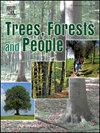Physiological adaptations to different shade levels and their role in enhancing yield and quality of Ficus formosana Maxim. for under-forest economy: Insights from greenhouse and forest environments
IF 2.9
Q1 FORESTRY
引用次数: 0
Abstract
Ficus formosana Maxim., an emerging under-forest economic crop, adapts to understory environments but exhibits growth variations under different canopy and light conditions. This study analyzed the growth, physiological, and biochemical responses of F. formosana under three shading gradients in greenhouse and broadleaved forest environments to evaluate the effects of light intensity on plant performance. After eight months, plants in unshaded forest environments showed increased hydrogen peroxide and malondialdehyde levels and reduced Fv/Fm, indicating oxidative stress and photosystem damage. In contrast, severe shading promoted chlorophyll content, specific leaf area, and leaf area ratio, enhancing light capture, but restricted stomatal conductance and carbon assimilation, ultimately limiting metabolite production and biomass accumulation. Growth patterns in the greenhouse were consistent with those in the forest. However, physiological and morphological adaptations were observed across all shading conditions in the forest, highlighting the excellent shade tolerance and adaptive regulation of F. formosana in the understory environment. Optimal growth occurred under moderate shading, with 21 % relative light intensity and a daily light integral of ∼4 mol photons m−2 day−1, achieving the highest biomass and stable root secondary metabolite levels and DPPH scavenging activity. These findings underscore the critical role of optimizing light intensity in the cultivation of under-forest economic crops. For F. formosana, moderate shading provides the most favorable conditions for maximizing root yield, while simultaneously maintaining its antioxidant quality, thereby enhancing its economic viability.
对不同遮荫程度的生理适应及其在提高林下经济榕树产量和质量方面的作用:温室和森林环境的启示
台湾无花果。林下经济作物是一种新兴的林下经济作物,它适应林下环境,但在不同冠层和光照条件下表现出生长变化。本研究分析了在温室和阔叶林三种遮荫梯度下,台湾红木的生长和生理生化反应,以评价光照强度对植物生长性能的影响。8个月后,在无遮蔽的森林环境中,植物的过氧化氢和丙二醛水平升高,Fv/Fm降低,表明氧化应激和光系统损伤。相反,重度遮荫提高了叶绿素含量、比叶面积和叶面积比,增强了光捕获,但限制了气孔导度和碳同化,最终限制了代谢物的产生和生物量的积累。温室中的生长模式与森林中的生长模式一致。然而,在森林中所有遮荫条件下,都观察到生理和形态上的适应,这表明台湾杉木在林下环境中具有良好的遮荫耐受性和适应性调节。最佳生长条件为中等遮荫,相对光照强度为21%,日光照积分为~ 4 mol光子m−2 day−1,生物量最高,根系次生代谢物水平稳定,DPPH清除活性高。这些发现强调了优化光照强度在林下经济作物栽培中的关键作用。适度遮荫既能最大限度地提高根产量,又能保持其抗氧化品质,从而提高其经济活力。
本文章由计算机程序翻译,如有差异,请以英文原文为准。
求助全文
约1分钟内获得全文
求助全文
来源期刊

Trees, Forests and People
Economics, Econometrics and Finance-Economics, Econometrics and Finance (miscellaneous)
CiteScore
4.30
自引率
7.40%
发文量
172
审稿时长
56 days
 求助内容:
求助内容: 应助结果提醒方式:
应助结果提醒方式:


